Influence of Thickness on Water Absorption and Tensile Strength of BFRP Laminates in Water or Alkaline Solution and a Thickness-Dependent Accelerated Ageing Method for BFRP Laminates
Abstract
1. Introduction
2. Materials and Methods
2.1. Materials and Laminates Fabrication
2.2. Water Absorption Test
2.3. Tensile Test
2.4. Scanning Electron Microscopy
3. Test Results
3.1. Water Absorption
3.2. Tensile Properties


4. Discussions
4.1. Influence of Thickness on Water Absorption
4.2. Influence of Thickness on Tensile Strength
5. Theoretical Model of Accelerated Factor
5.1. Accelerated Factor of Water Absorption
5.2. Accelerated Factor of Tensile Strength Retention
5.3. Model Validation and Discussions
6. Conclusions
Author Contributions
Acknowledgments
Conflicts of Interest
Abbreviations
| FRP | Fiber-reinforced polymer |
| BFRP | Basalt FRP |
| CFRP | Carbon FRP |
| GFRP | Glass FRP |
| AFRP | Aramid FRP |
| RC | reinforced concrete |
| VARI | vacuum assistant resin infusion |
| SEM | scanning electron microscopy |
| AF | accelerated factor |
References
- Wei, Y.; Zhang, Y.; Chai, J.; Wu, G.; Dong, Z. Experimental investigation of rectangular concrete-filled fiber reinforced polymer (FRP)-steel composite tube columns for various corner radii. Compos. Struct. 2020, 244, 112311. [Google Scholar] [CrossRef]
- Bai, Y.L.; Dai, J.G.; Mohammadi, M.; Lin, G.; Mei, S.J. Stiffness-based design-oriented compressive stress-strain model for large-rupture-strain (LRS) FRP-confined concrete. Compos. Struct. 2019, 223, 110953. [Google Scholar] [CrossRef]
- Wang, Y.; Cai, G.; Li, Y.; Waldmann, D.; Si Larbi, A.; Tsavdaridis, K.D. Behavior of circular fiber-reinforced polymer-steel-confined concrete columns subjected to reversed cyclic loads: Experimental studies and finite-element analysis. J. Struct. Eng. 2019, 145, 04019085. [Google Scholar] [CrossRef]
- Zeng, J.; Gao, W.; Duan, Z.; Bai, Y.; Guo, Y.C.; Ouyang, L.J. Axial compressive behavior of polyethylene terephthalate/carbon FRP-confined seawater sea-sand concrete in circular columns. Constr. Build. Mater. 2020, 234, 117383. [Google Scholar] [CrossRef]
- Cao, Q.; Tao, J.; Wu, Z.; Ma, Z.J. Behavior of FRP-Steel confined concrete tubular columns made of expansive self-consolidating concrete under axial compression. J. Compos. Constr. 2017, 21, 04017037-1-12. [Google Scholar] [CrossRef]
- Bai, Y.L.; Yan, Z.W.; Ozbakkaloglu, T.; Han, Q.; Dai, J.G.; Zhu, D.J. Quasi-static and dynamic tensile properties of large-rupture-strain (LRS) polyethylene terephthalate fiber bundle. Constr. Build. Mater. 2020, 232, 117241. [Google Scholar] [CrossRef]
- Wang, Y.; Wang, Y.; Han, B.; Wan, B.; Cai, G.; Chang, R. In situ strain and damage monitoring of GFRP laminates incorporating carbon nanofibers under tension. Polymers 2018, 10, 777. [Google Scholar] [CrossRef]
- Cao, Q.; Li, H.; Lin, Z. Effect of active confinement on GFRP confined expansive concrete under axial cyclic loading. ACI Struct. J. 2020, 117, 207–216. [Google Scholar] [CrossRef]
- Wang, Y.; Chen, G.; Wan, B.; Cai, G.; Zhang, Y. Behavior of circular ice-filled self-luminous FRP tubular stub columns under axial compression. Constr. Build. Mater. 2020, 232, 117287. [Google Scholar] [CrossRef]
- Wei, Y.; Zhang, X.; Wu, G.; Zhou, Y. Behaviour of concrete confined by both steel spirals and fiber-reinforced polymer under axial load. Compos. Struct. 2018, 192, 577–591. [Google Scholar] [CrossRef]
- Zhang, Y.; Wei, Y.; Bai, J.; Zhang, Y. Stress-strain model of an FRP-confined concrete filled steel tube under axial compression. Thin Walled Struct. 2019, 142, 149–159. [Google Scholar] [CrossRef]
- Zhai, K.; Fang, H.; Fu, B.; Wang, F.; Hu, B. Mechanical response of externally bonded CFRP on repair of PCCPs with broken wires under internal water pressure. Constr. Build. Mater. 2020, 239, 117878. [Google Scholar] [CrossRef]
- Wang, Y.; Wang, Y.; Wan, B.; Han, B.; Cai, G.; Li, Z. Properties and mechanisms of self-sensing carbon nanofibers/epoxy composites for structural health monitoring. Compos. Struct. 2018, 200, 669–678. [Google Scholar] [CrossRef]
- Lu, M.; Xiao, H.; Liu, M.; Li, X.; Li, H.; Sun, L. Improved interfacial strength of SiO2 coated carbon fiber in cement matrix. Cem. Concr. Compos. 2018, 91, 21–28. [Google Scholar] [CrossRef]
- He, J.; Xian, G.; Zhang, Y.X. Effect of moderately elevated temperatures on bond behaviour of CFRP-to-steel bonded joints using different adhesives. Constr. Build. Mater. 2020, 241, 118057. [Google Scholar] [CrossRef]
- Li, J.; Xie, J.; Liu, F.; Lu, Z. A critical review and assessment for FRP-concrete bond systems with epoxy resin exposed to chloride environments. Compos. Struct. 2019, 229, 111372. [Google Scholar] [CrossRef]
- Huang, H.; Jia, B.; Lian, J.; Wang, W. Experimental investigation on the tensile performance of resin-filled steel pipe splices of BFRP bars. Constr. Build. Mater. 2020, 242, 118018. [Google Scholar] [CrossRef]
- Dong, Z.; Wu, G.; Xu, B.; Wang, X.; Taerwe, L. Bond durability of BFRP bars embedded in concrete under seawater conditions and the long-term bond strength prediction. Mater. Des. 2016, 92, 552–562. [Google Scholar] [CrossRef]
- Li, Y.; Wang, Y.; Ou, J. Mechanical behavior of BFRP-steel composite plate under axial tension. Polymers. 2014, 6, 1862–1876. [Google Scholar] [CrossRef]
- Wang, Y.; Wang, Y.; Wan, B.; Han, B.; Cai, G.; Chang, R. Strain and damage self-sensing of basalt fiber reinforced polymer laminates fabricated with carbon nanofibers/epoxy composites under tension. Compos. Part A Appl. Sci. Manuf. 2018, 113, 40–52. [Google Scholar] [CrossRef]
- Dong, Z.; Wu, G.; Zhao, X.L.; Zhu, H.; Wei, Y.; Yan, Z. Mechanical properties of discrete BFRP needles reinforced seawater sea-sand concrete-filled GFRP tubular stub columns. Constr. Build. Mater. 2020, 244, 118330. [Google Scholar] [CrossRef]
- Nguyen, V.D.; Hao, J.; Wang, W. Ultraviolet weathering performance of high-density polyethylene/wood-flour composites with a basalt-fiber-included shell. Polymers 2018, 10, 831. [Google Scholar] [CrossRef] [PubMed]
- Wang, Z.; Zhao, X.L.; Xian, G.; Wu, G.; Singh Raman, R.K.; Al-Saadi, S. Durability study on interlaminar shear behaviour of basalt-, glass- and carbon-fibre reinforced polymer (B/G/CFRP) bars in seawater sea sand concrete environment. Constr. Build. Mater. 2017, 156, 985–1004. [Google Scholar] [CrossRef]
- Quagliarini, E.; Monni, F.; Bondioli, F.; Lenci, S. Basalt fiber ropes and rods: Durability tests for their use in building engineering. J. Build. Eng. 2016, 5, 142–150. [Google Scholar] [CrossRef]
- Li, S.; Hu, J.; Ren, H. The combined effects of environmental conditioning and sustained load on mechanical properties of wet lay-up fiber reinforced polymer. Polymers 2017, 9, 244. [Google Scholar] [CrossRef]
- Sharma, B.; Chhibber, R.; Mehta, R. Seawater ageing of glass fiber reinforced epoxy nanocomposites based on silylated clays. Polym. Degrad. Stab. 2018, 147, 103–114. [Google Scholar] [CrossRef]
- Jiang, X.; Luo, C.; Qiang, X.; Zhang, Q.; Kolstein, H.; Bijlaard, F. Coupled hygro-mechanical finite element method on determination of the interlaminar shear modulus of glass fiber-reinforced polymer laminates in bridge decks under hygrothermal aging effects. Polymers 2018, 10, 845. [Google Scholar] [CrossRef]
- Lu, Z.; Xian, G.; Li, H. Effects of thermal aging on the water uptake behavior of pultruded BFRP plates. Polym. Degrad. Stab. 2014, 110, 216–224. [Google Scholar] [CrossRef]
- Lu, Z.; Xian, G.; Li, H. Effects of exposure to elevated temperatures and subsequent immersion in water or alkaline solution on the mechanical properties of pultruded BFRP plates. Compos. Part B Eng. 2015, 77, 421–430. [Google Scholar] [CrossRef]
- Ma, G.; Yan, L.; Shen, W.; Zhu, D.; Huang, L.; Kasal, B. Effects of water, alkali solution and temperature ageing on water absorption, morphology and mechanical properties of natural FRP composites: Plant-based jute vs. mineral-based basalt. Compos. Part B Eng. 2018, 153, 398–412. [Google Scholar] [CrossRef]
- Xiao, B.; Li, H.; Xian, G. Hygrothermal ageing of basalt fiber reinforced epoxy composites. In Advances in FRP Composites in Civil Engineering, Proceedings of the 5th International Conference on FRP Composites in Civil Engineering, CICE 2010, Beijing, China, 27–29 September 2010; Springer: Berlin/Heidelberg, Germany, 2011; pp. 356–359. [Google Scholar]
- Wu, G.; Wang, X.; Wu, Z.; Dong, Z.; Zhang, G. Durability of basalt fibers and composites in corrosive environments. J. Compos. Mater. 2015, 49, 873–887. [Google Scholar] [CrossRef]
- Li, X.; Yahya, M.Y.; Nia, A.B.; Wang, Z.; Yang, J.; Lu, G. Dynamic failure of basalt/epoxy laminates under blast—Experimental observation. Int. J. Impact Eng. 2017, 102, 16–26. [Google Scholar] [CrossRef]
- Benmokrane, B.; Manalo, A.; Bouhet, J.C.; Mohamed, K.; Robert, M. Effects of diameter on the durability of glass fiber-reinforced polymer bars conditioned in alkaline solution. J. Compos. Constr. 2017, 21, 04017040. [Google Scholar] [CrossRef]
- Wu, G.; Wang, X.; Wu, Z.; Dong, Z.; Xie, Q. Degradation of basalt FRP bars in alkaline environment. Sci. Eng. Compos. Mater. 2015, 22, 649–657. [Google Scholar] [CrossRef]
- Chen, Y.; Davalos, J.F.; Ray, I. Durability prediction for GFRP reinforcing bars using short-term data of accelerated aging tests. J. Compos. Constr. 2006, 10, 279–286. [Google Scholar] [CrossRef]
- Wang, Z.; Xian, G.; Zhao, X.L. Effects of hydrothermal aging on carbon fibre/epoxy composites with different interfacial bonding strength. Constr. Build. Mater. 2018, 161, 634–648. [Google Scholar] [CrossRef]
- Wang, Y.; Cai, G.; Si Larbi, A.; Waldmann, D.; Tsavdaridis, K.D.; Ran, J. Monotonic axial compressive behaviour and confinement mechanism of square CFRP-steel tube confined concrete. Eng. Struct. 2020, in press. [Google Scholar]
- ASTM International. Standard Test Method for Moisture Absorption Properties and Equilibrium Conditioning of Polymer Matrix Composite Materials (ASTM D5229/D5229-14); ASTM International: West Conshohocken, PA, USA, 2014. [Google Scholar]
- American Concrete Institute. Guide Test Methods for Fiber-Reinforced Polymers (FRPs) for Reinforcing or Strengthening Concrete Structures; A.C.I. Committee 440, Report 440.3R-12; American Concrete Institute: Farmington Hills, MI, USA, 2012. [Google Scholar]
- ASTM International. Standard Test Method for Tensile Properties of Polymer Matrix Composite Materials (ASTM D3039/D3039M-14); ASTM International: West Conshohocken, PA, USA, 2014. [Google Scholar]
- Hong, B.; Xian, G.; Wang, Z. Durability study of pultruded carbon fiber reinforced polymer plates subjected to water immersion. Adv. Struct. Eng. 2018, 21, 571–579. [Google Scholar] [CrossRef]
- Agwa, M.A.; Taha, I.; Megahed, M. Experimental and analytical investigation of water diffusion process in nano-carbon/alumina/silica filled epoxy nanocomposites. Int. J. Mech. Mater. Des. 2017, 13, 607–615. [Google Scholar] [CrossRef]
- Almeida, J.H.S.; Souza, S.D.B.; Botelho, E.C.; Amico, S.C. Carbon fiber-reinforced epoxy filament-wound composite laminates exposed to hygrothermal conditioning. J. Mater. Sci. 2016, 51, 4697–4708. [Google Scholar] [CrossRef]
- Chin, J.W.; Nguyen, T.; Aouadi, K. Sorption and Diffusion of water, salt water, and concrete. J. Appl. Polym. Sci. 1999, 71, 483–492. [Google Scholar] [CrossRef]
- Garg, M.; Sharma, S.; Mehta, R. Carbon nanotube-reinforced glass fiber epoxy composite laminates exposed to hygrothermal conditioning. J. Mater. Sci. 2016, 51, 8562–8578. [Google Scholar] [CrossRef]
- Wang, Z.; Zhao, X.L.; Xian, G.; Wu, G.; Singh Raman, R.K.; Al-Saadi, S.; Haque, A. Long-term durability of basalt- and glass-fibre reinforced polymer (BFRP/GFRP) bars in seawater and sea sand concrete environment. Constr. Build. Mater. 2017, 139, 467–489. [Google Scholar] [CrossRef]
- Shi, J.; Wang, X.; Wu, Z.; Zhu, Z. Fatigue behavior of basalt fiber-reinforced polymer tendons under a marine environment. Constr. Build. Mater. 2017, 137, 46–54. [Google Scholar] [CrossRef]
- Hojo, H.; Tsuda, K.; Ogasawara, K. Form and rate of corrosion of corrosion-resistant FRP resins. Adv. Compos. Mater. 1991, 1, 55–67. [Google Scholar] [CrossRef]
- Bao, L.R.; Yee, A.F. Effect of temperature on moisture absorption in a bismaleimide resin and its carbon fiber composites. Polymer 2002, 43, 3987–3997. [Google Scholar] [CrossRef]
- Satterfleld, M.B.; Benziger, J.B. Non-Fickian water vapor sorption dynamics by nafion membranes. J. Phys. Chem. B 2008, 112, 3693–3704. [Google Scholar] [CrossRef]
- Zhang, X.; Wang, Y.; Wan, B.; Cai, G.; Qu, Y. Effect of specimen thicknesses on water absorption and flexural strength of CFRP laminates subjected to water or alkaline solution immersion. Constr. Build. Mater. 2019, 208, 314–325. [Google Scholar] [CrossRef]
- Wang, Y.; Zhang, X.; Cai, G.; Wan, B.; Waldmann, D.; Qu, Y. A new thickness-based accelerated aging test methodology for resin materials: Theory and preliminary experimental study. Constr. Build. Mater. 2018, 186, 986–995. [Google Scholar] [CrossRef]
- Pi, Z.; Xiao, H.; Du, J.; Liu, M.; Li, H. Interfacial microstructure and bond strength of nano-SiO2-coated steel fibers in cement matrix. Cem. Concr. Compos. 2019, 103, 1–10. [Google Scholar] [CrossRef]
- Phani, K.K.; Bose, N.R. Hydrothermal ageing of CSM-laminate during water immersion—An acousto-ultrasonic study. J. Mater. Sci. 1986, 21, 3633–3637. [Google Scholar] [CrossRef]
- Li, C.; Xian, G.; Li, H. Effect of postcuring immersed in water under hydraulic pressure on fatigue performance of large-diameter pultruded carbon/glass hybrid rod. Fatigue Fract. Eng. Mater. Struct. 2019, 42, 1148–1160. [Google Scholar] [CrossRef]

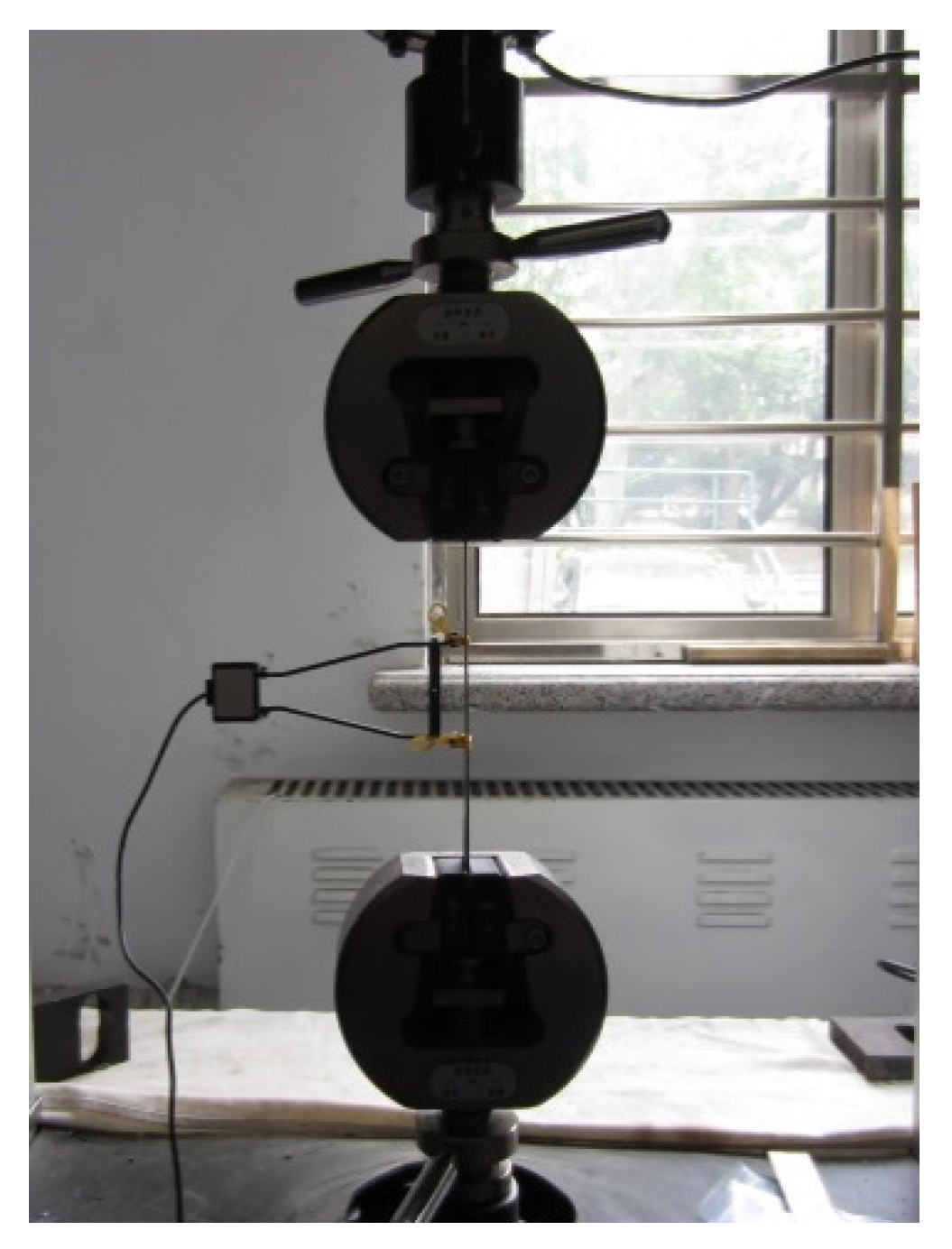
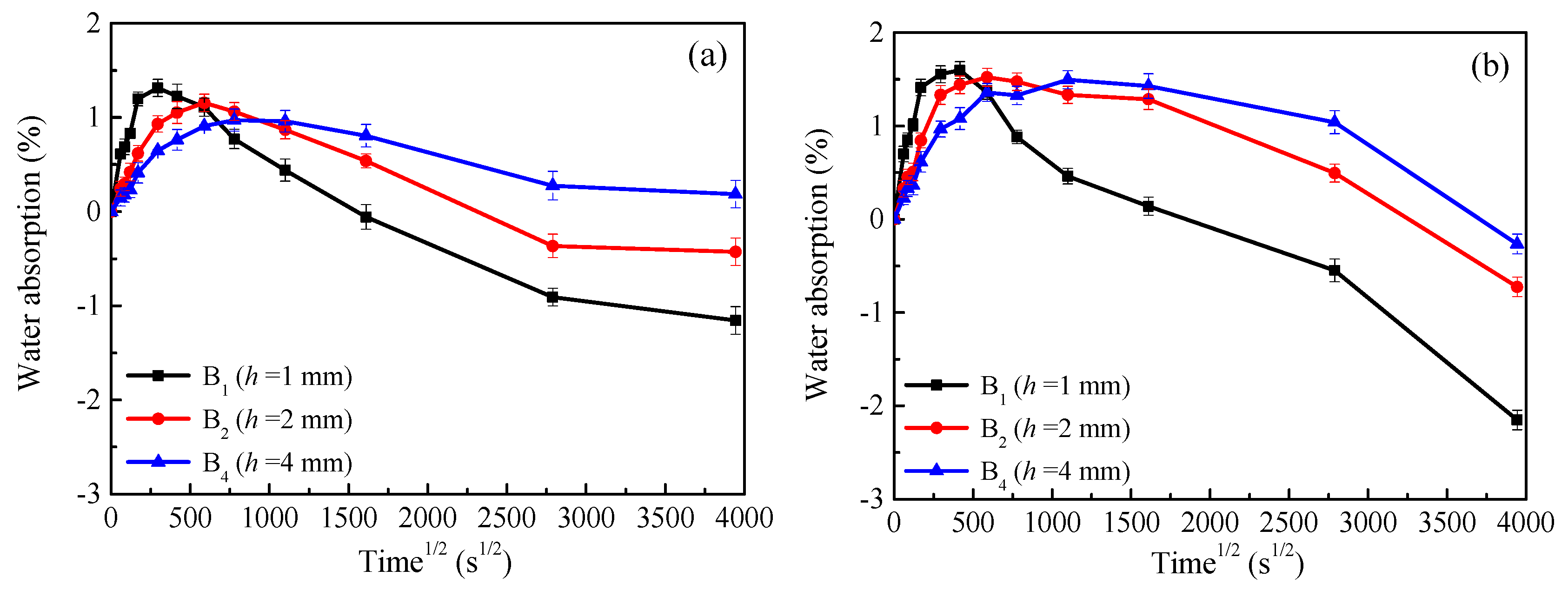
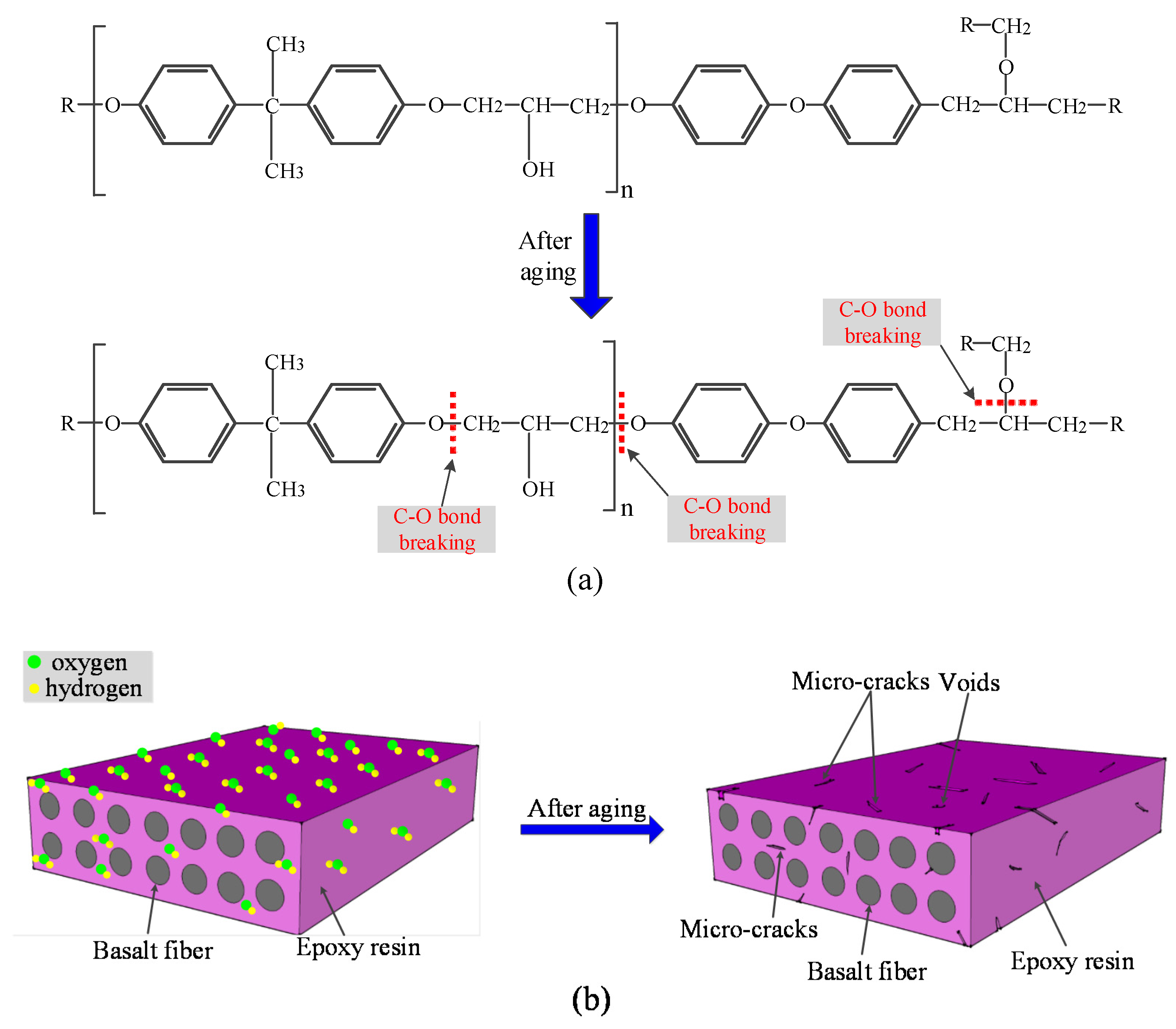

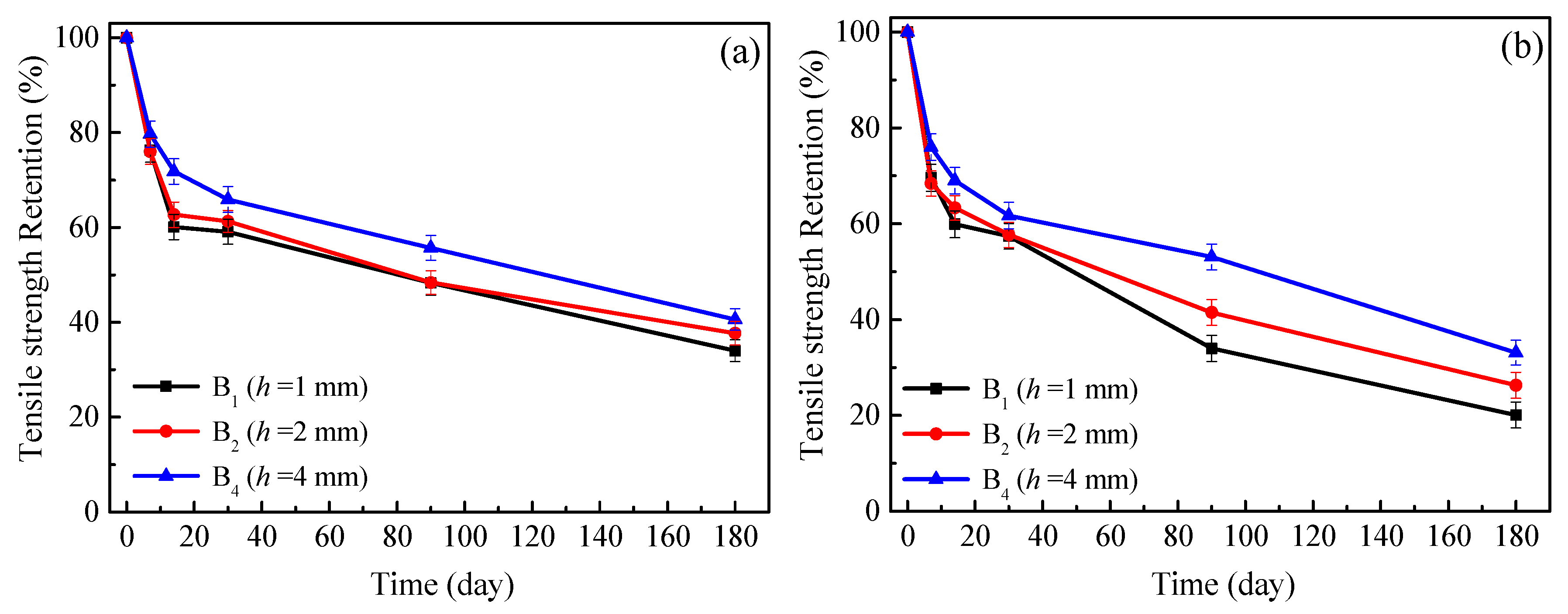
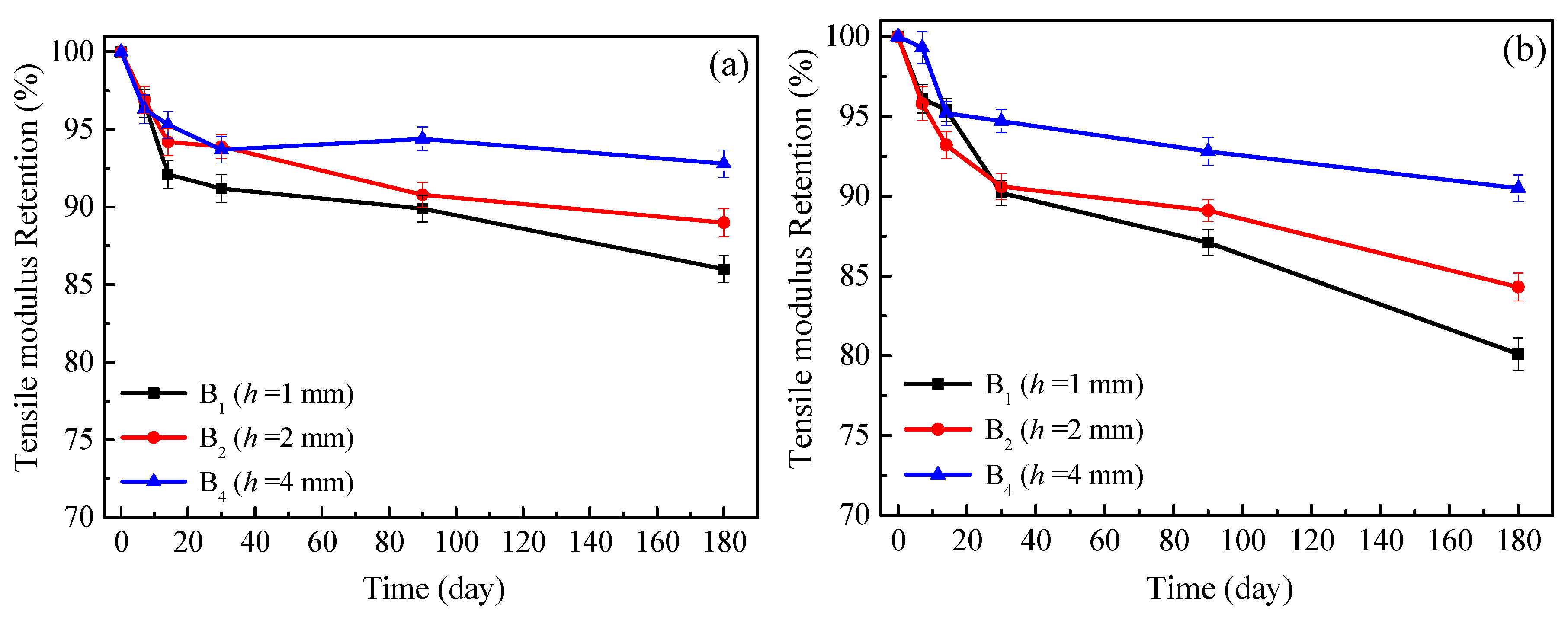
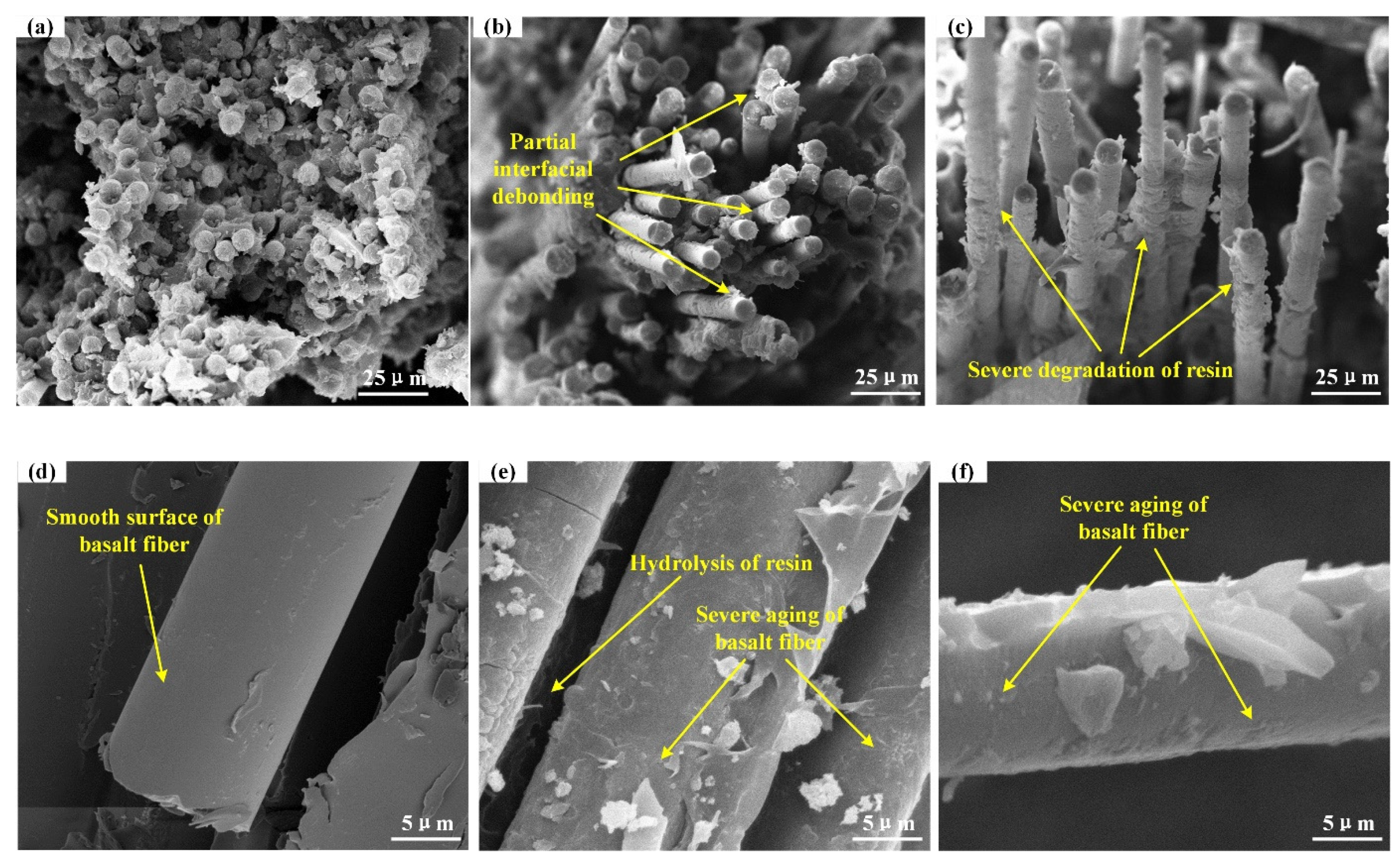
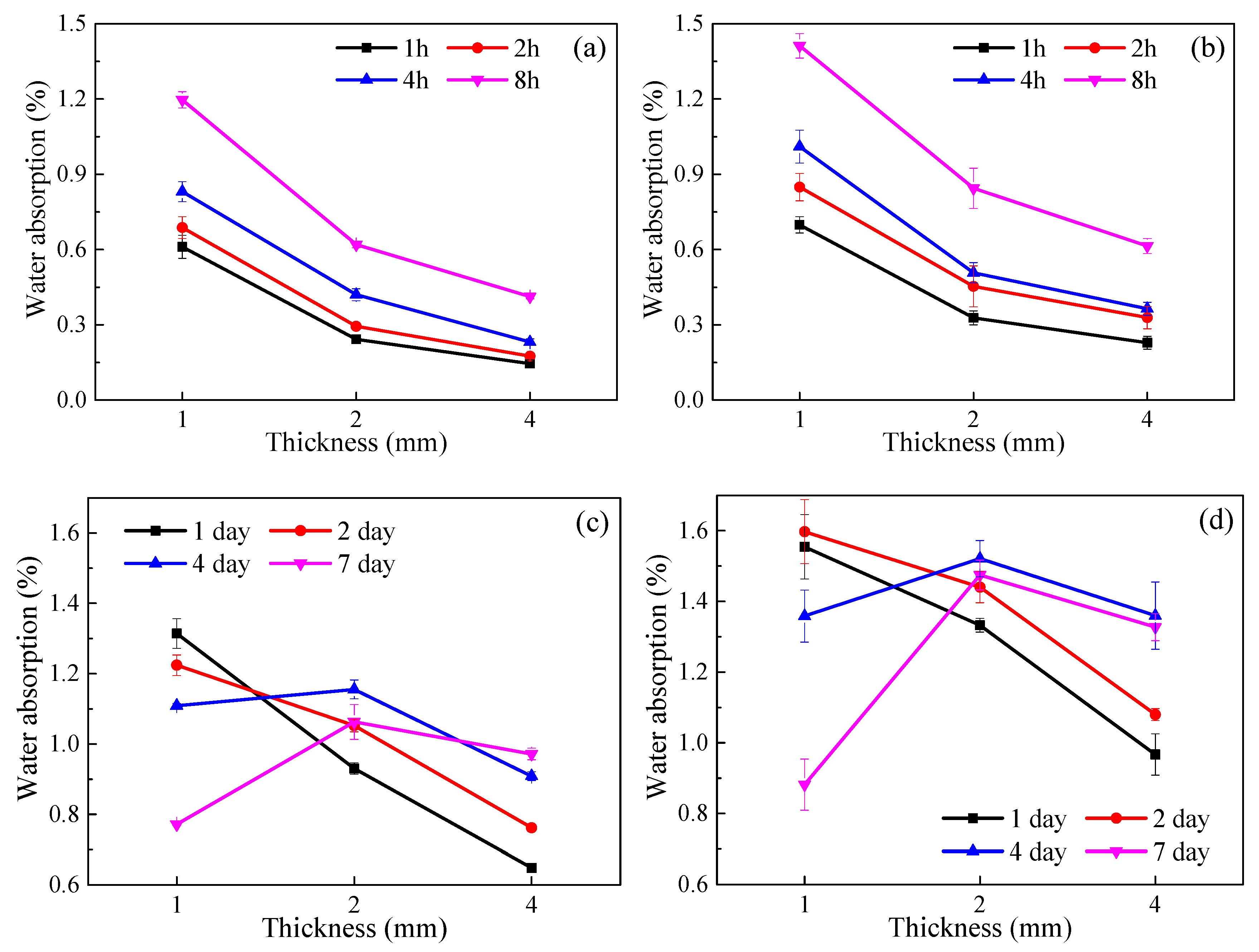
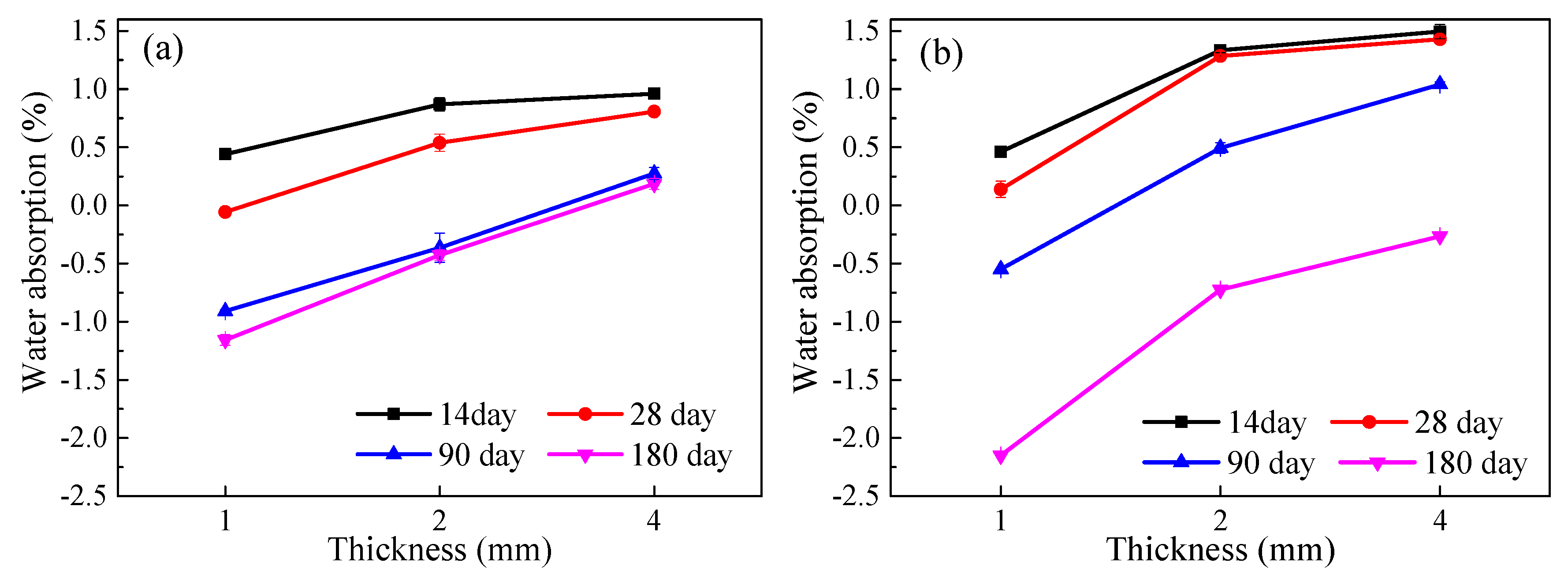
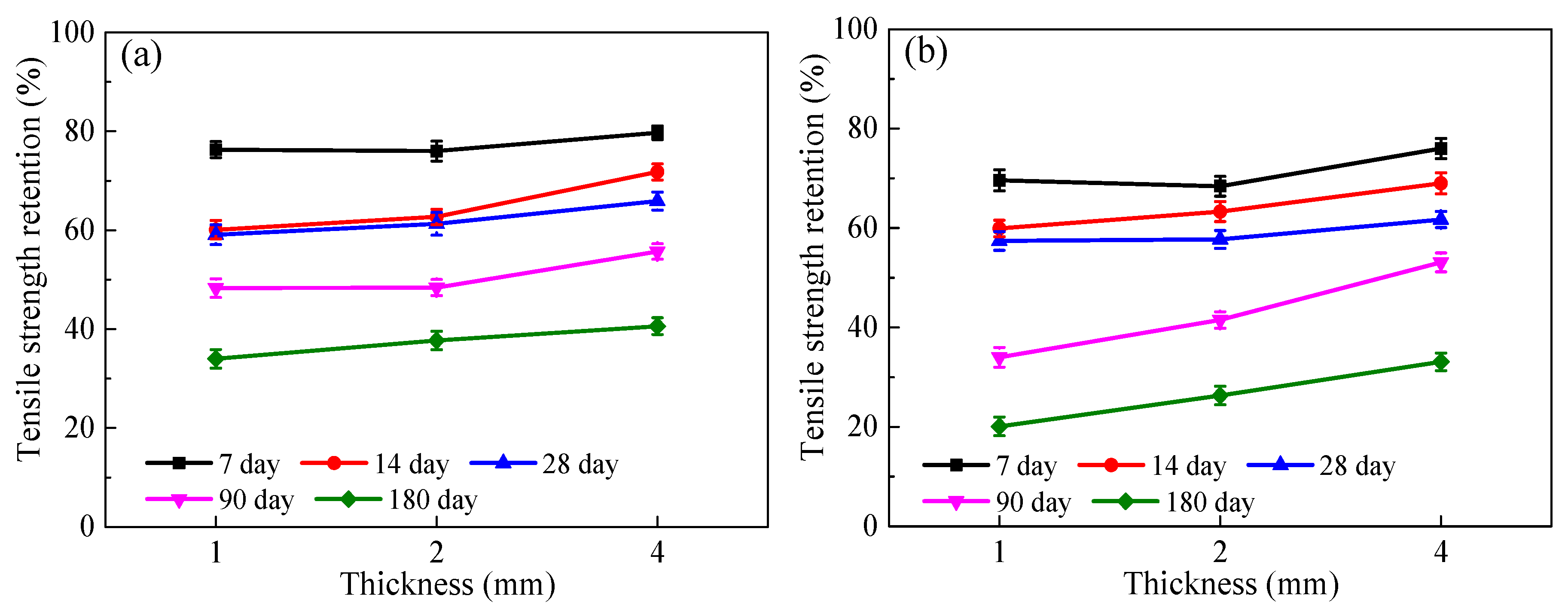
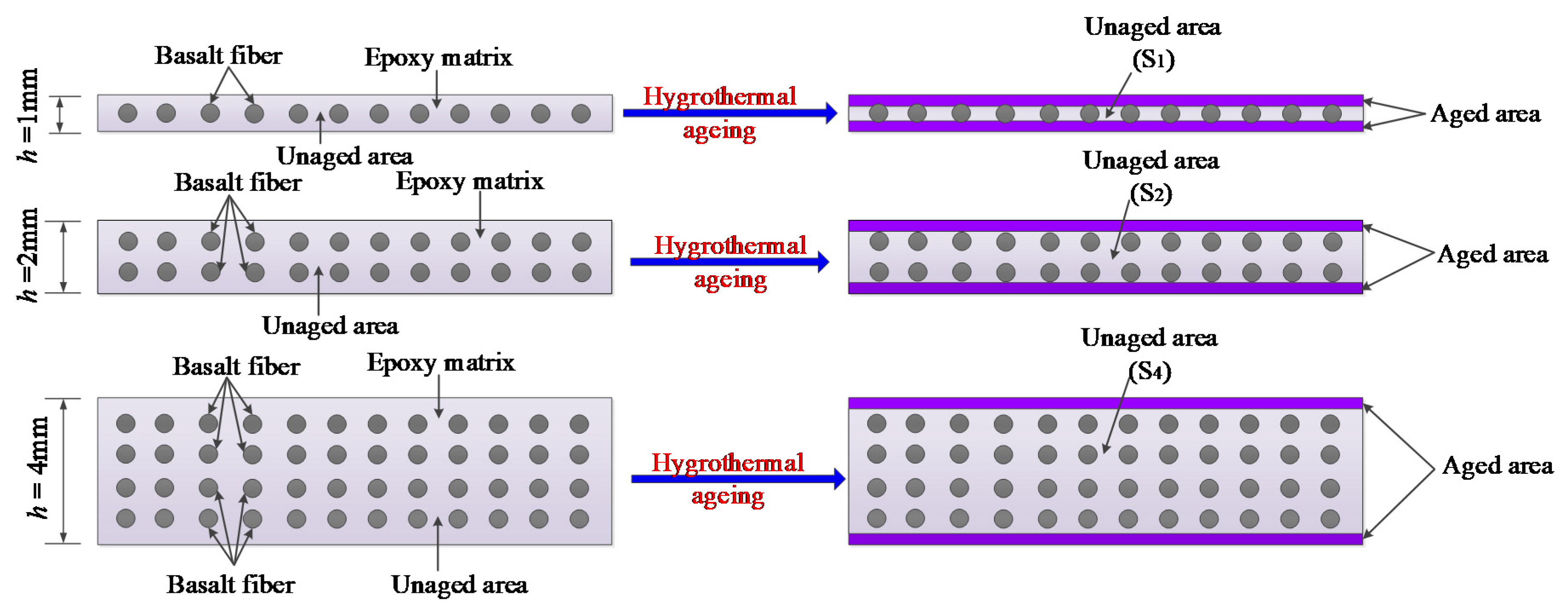

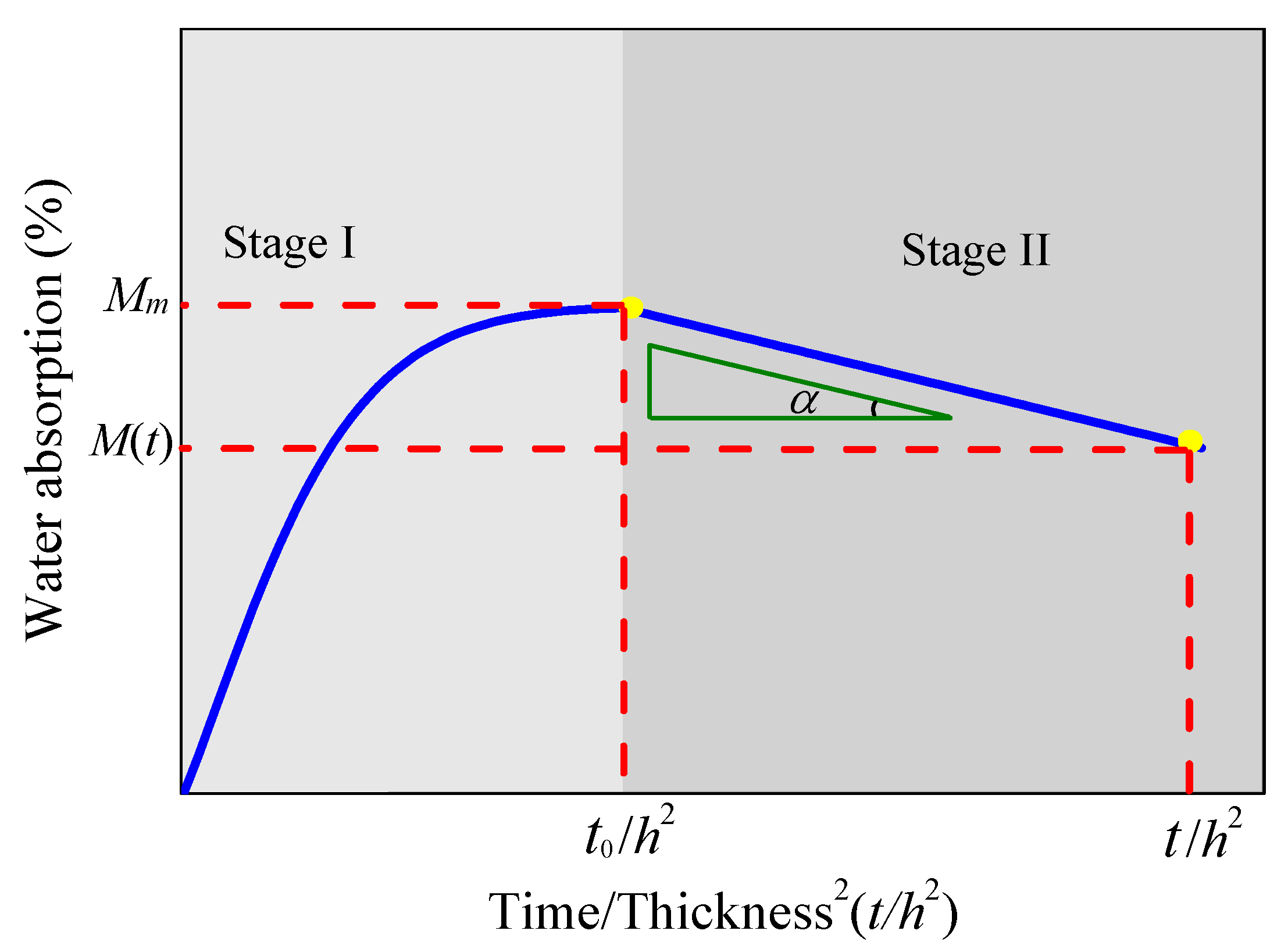
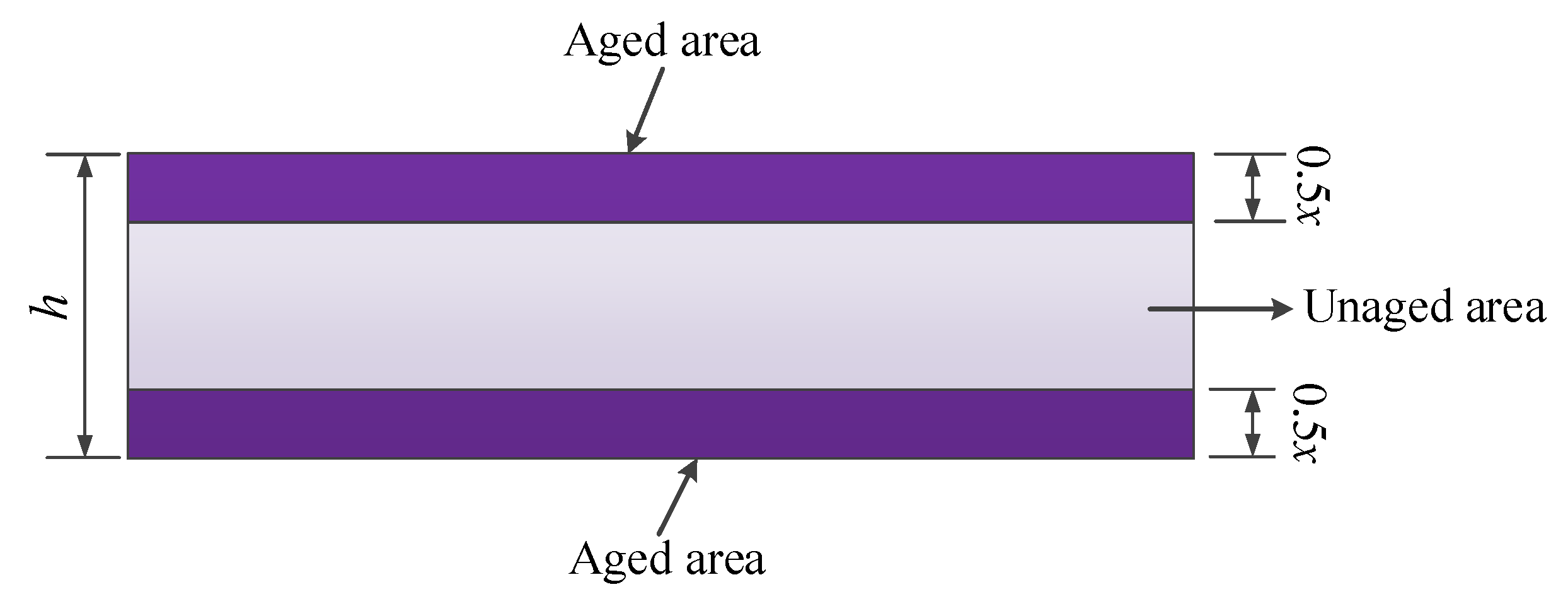
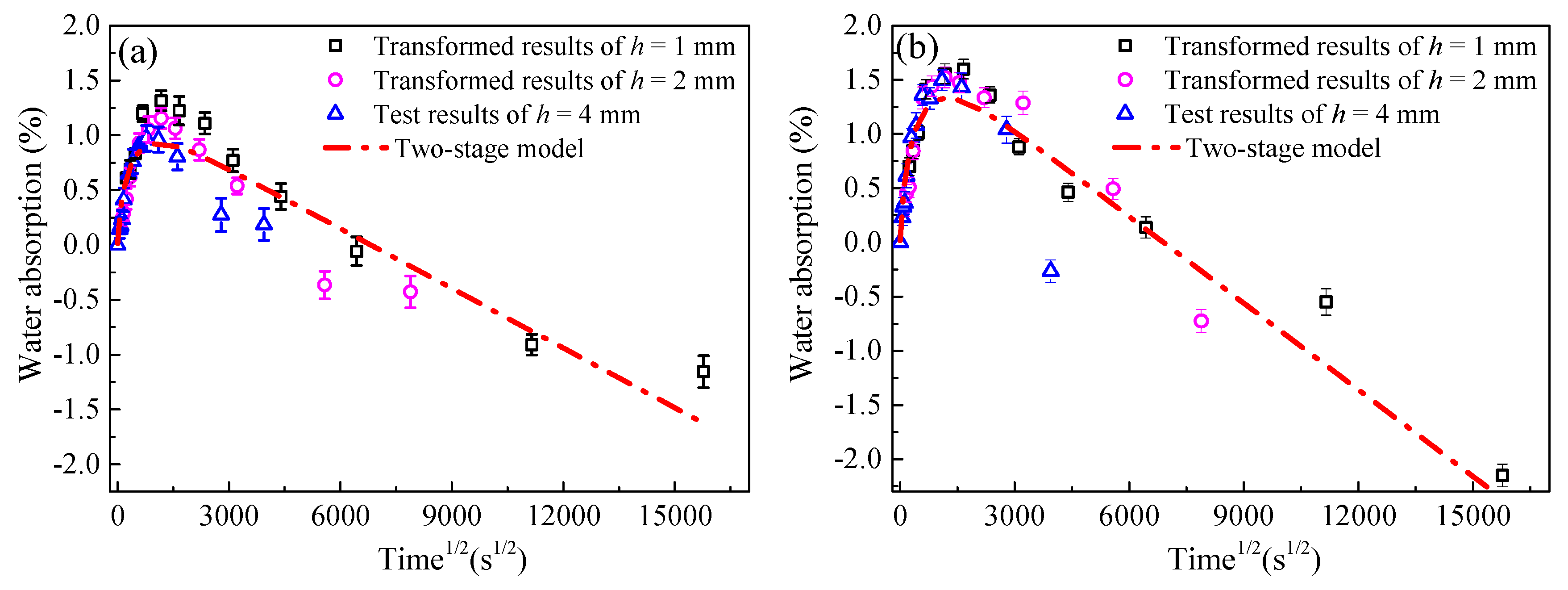
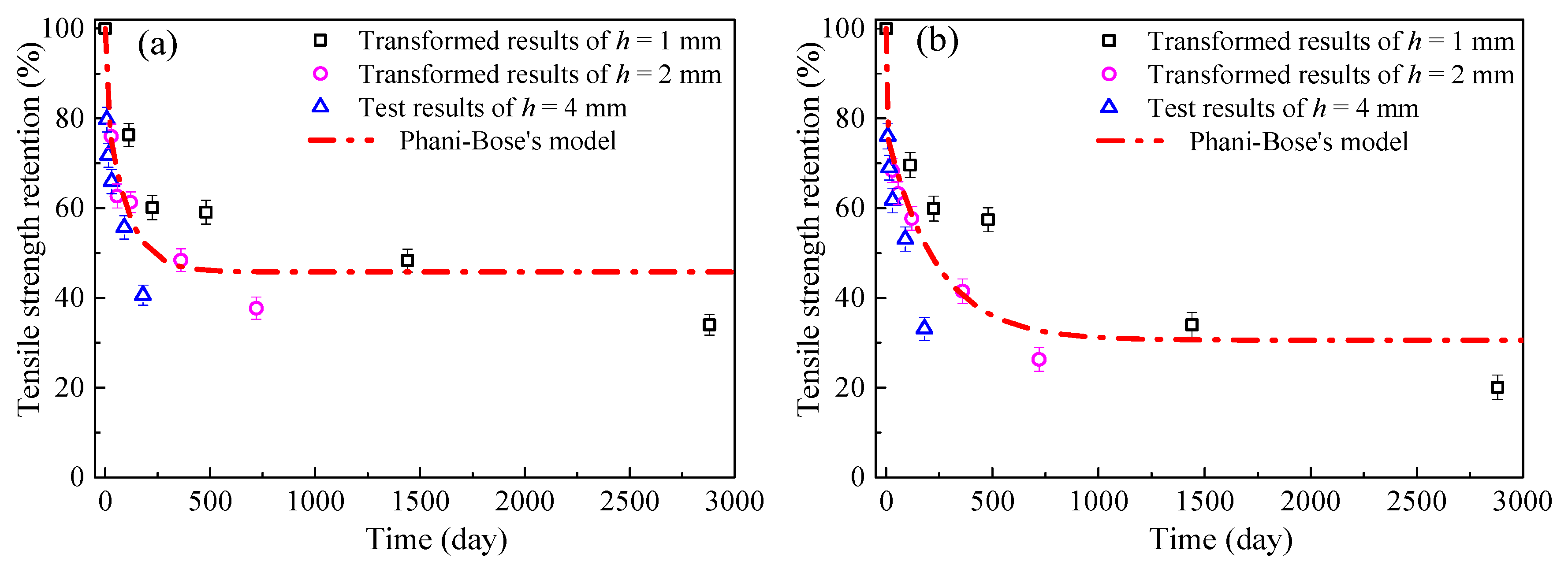
| Material | Tensile Strength (MPa) | Elastic Modulus (GPa) | Elongation at Break (%) |
|---|---|---|---|
| Basalt fiber fabric | 2100 | 91 | 2.6 |
| Epoxy resin | >40 | >2.5 | >1.8 |
| Specimen Thickness | Ageing Days | Deionized Water | Alkaline Solution | ||
|---|---|---|---|---|---|
| f (MPa) | E (GPa) | f (MPa) | E (GPa) | ||
| 1 mm (B1) | 0 | 1763 ± 41 | 81.8 ± 0.8 | 1763 ± 41 | 81.8 ± 0.8 |
| 7 | 1345 ± 34 | 79.1 ± 0.7 | 1227 ± 34 | 78.6 ± 0.7 | |
| 14 | 1059 ± 28 | 75.3 ± 0.7 | 1056 ± 29 | 78.0 ± 0.6 | |
| 30 | 1042 ± 28 | 74.6 ± 0.7 | 1012 ± 27 | 79.7 ± 0.6 | |
| 90 | 851 ± 22 | 73.5 ± 0.7 | 599 ± 16 | 78.2 ± 0.6 | |
| 180 | 600 ± 14 | 70.3 ± 0.6 | 354 ± 10 | 65.5 ± 0.7 | |
| 2 mm (B2) | 0 | 1830 ± 44 | 85.1 ± 0.9 | 1830 ± 44 | 85.1 ± 0.8 |
| 7 | 1390 ± 38 | 82.5 ± 0.7 | 1252 ± 34 | 81.5 ± 0.9 | |
| 14 | 1148 ± 31 | 80.2 ± 0.7 | 1159 ± 30 | 79.3 ± 0.7 | |
| 30 | 1121± 26 | 79.9 ± 0.6 | 1057 ± 28 | 77.0 ± 0.6 | |
| 90 | 885± 22 | 77.3 ± 0.6 | 759 ± 21 | 75.8 ± 0.5 | |
| 180 | 689 ± 17 | 75.7 ± 0.7 | 481 ± 13 | 71.7 ± 0.6 | |
| 4 mm (B4) | 0 | 1782 ± 42 | 83.5 ± 0.8 | 1782 ± 42 | 83.5 ± 0.8 |
| 7 | 1420 ± 39 | 80.4 ± 0.7 | 1354 ± 38 | 82.9 ± 0.6 | |
| 14 | 1279 ± 34 | 78.5 ± 0.7 | 1230 ± 34 | 79.5 ± 0.6 | |
| 30 | 1174 ± 32 | 78.2 ± 0.6 | 1099 ± 30 | 79.1 ± 0.6 | |
| 90 | 993 ± 26 | 78.8 ± 0.6 | 946 ± 25.4 | 77.5 ± 0.7 | |
| 180 | 723 ± 16.2 | 77.5 ± 0.7 | 590 ± 15.2 | 75.6 ± 0.6 | |
| Specimen Thickness | |||
|---|---|---|---|
| 1 mm | 2 mm | 4 mm | |
| Accelerated factor (AF) | 16 | 4 | 1 |
© 2020 by the authors. Licensee MDPI, Basel, Switzerland. This article is an open access article distributed under the terms and conditions of the Creative Commons Attribution (CC BY) license (http://creativecommons.org/licenses/by/4.0/).
Share and Cite
Wang, Y.; Zhu, W.; Zhang, X.; Cai, G.; Wan, B. Influence of Thickness on Water Absorption and Tensile Strength of BFRP Laminates in Water or Alkaline Solution and a Thickness-Dependent Accelerated Ageing Method for BFRP Laminates. Appl. Sci. 2020, 10, 3618. https://doi.org/10.3390/app10103618
Wang Y, Zhu W, Zhang X, Cai G, Wan B. Influence of Thickness on Water Absorption and Tensile Strength of BFRP Laminates in Water or Alkaline Solution and a Thickness-Dependent Accelerated Ageing Method for BFRP Laminates. Applied Sciences. 2020; 10(10):3618. https://doi.org/10.3390/app10103618
Chicago/Turabian StyleWang, Yanlei, Wanxin Zhu, Xue Zhang, Gaochuang Cai, and Baolin Wan. 2020. "Influence of Thickness on Water Absorption and Tensile Strength of BFRP Laminates in Water or Alkaline Solution and a Thickness-Dependent Accelerated Ageing Method for BFRP Laminates" Applied Sciences 10, no. 10: 3618. https://doi.org/10.3390/app10103618
APA StyleWang, Y., Zhu, W., Zhang, X., Cai, G., & Wan, B. (2020). Influence of Thickness on Water Absorption and Tensile Strength of BFRP Laminates in Water or Alkaline Solution and a Thickness-Dependent Accelerated Ageing Method for BFRP Laminates. Applied Sciences, 10(10), 3618. https://doi.org/10.3390/app10103618








